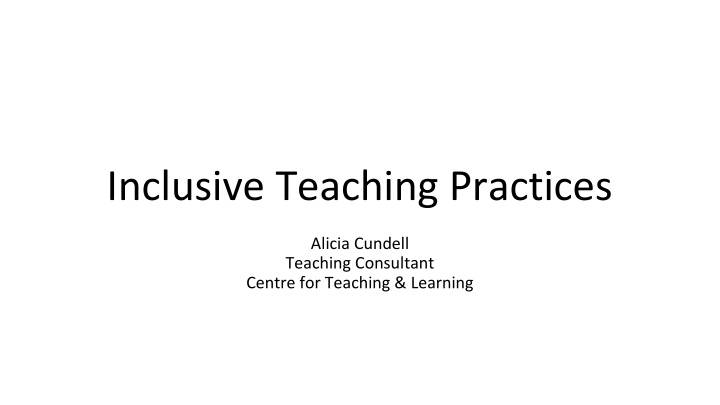



Inclusive Teaching Practices Alicia Cundell Teaching Consultant Centre for Teaching & Learning
Centre for Teaching & Learning (FB 620)
Today’s Goals & Objectives • Provide a space for participants to discuss issues of diversity and inclusion in the classroom • Describe theories related to diversity in the classroom • identify strategies to cultivate an inclusive classroom • analyze and evaluate common classroom scenarios and determine the best course of action based
A story by Lee Mun Wah
Think of a time when you felt like you did not belong. How did you feel? Write a few words to describe your feelings on a post-it note.
How often do you feel this way?
I am a white woman.
Based on your identities, background and/or experience, what is one way that you might be able to relate to some of your students?
What is one identity your students may hold that you cannot relate to?
Think of 3 things you can do to improve your blindspot
Implicit Bias • = Unconscious bias • Can be in conflict with conscious ideas/rational thought • Brains hardwired to prefer people who are like us (but, it is possible to have biases against our own group) • Implicit bias can be tested & reduced
Reducing Implicit Race Bias (Devine et al.) – Adapted for the classroom Strategy Technique Using examples of out-group members who counter Counter-stereotype the popular stereotype imaging Highlight people for their personal characteristics Individualizing (rather than those that might be stereotypical) Increase your exposure to out-group members & plan lessons so that students must interact more Contact regularly with students from their out-group
Stereotype Threat If you are trying to ”perform” a task/test for which a group that you identify with is negatively stereotyped, you will feel a certain stress/anxiety/pressure. This extra stress negatively impacts performance.
What do we know about Stereotype Threat?
Reducing Stereotype Threat Refer to: Empirically Validated Strategies to Reduce Stereotype Threat
Course Climate DeSurra & Church (1994) continuum Explicitly Implicitly Implicitly Explicitly marginalizing marginalizing Centralizing Centralizing
Get to know your students • Learn their names and use them • Find out more about them (i.e. class survey) • What challenges do you expect in this course? • What can I do to help you succeed/participate/learn in this class? • What is the most important thing I should know about you? / What would you like me to know about you? • Ice Breakers
Make Learning Accessible: Universal Design for Learning (UDL) • Provide Multiple Means of Representation • Provide Multiple Means of Action And Expression • Provide Multiple Means of Engagement
Managing Difficult Moments in the Classroom • Your job is NOT to make students agree with each other, but act as a facilitator to help students discuss and learn from different perspectives • Is it the appropriate time? • Is the topic linked to course outcomes?
“ Decades of research by organizational scientists, psychologists, sociologists, Diversity economists and demographers show that socially diverse groups is good (that is, those with a diversity of race, ethnicity, gender and for us sexual orientation) are more innovative than homogeneous groups . ”
Works cited Devine, P. G., Forscher, P. S., Austin, A. J., & Cox, W. T. L. (2012). Long-term reduction in implicit race bias: A prejudice habit-breaking intervention. Journal of Experimental Social Psychology, 48(6), 1267–1278. http://doi.org/10.1016/j.jesp.2012.06.003 Phillips, K. W. “How Diversity Makes us Smarter” Scientific American . Retrieved Nov. 27, 2017 from: https://www.scientificamerican.com/article/how-diversity-makes-us-smarter/
Recommend
More recommend